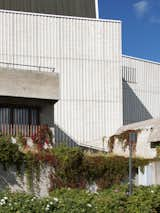A Finnish Photographer Captures Alvar Aalto’s Early Works in Their Shared Hometown
Like many New Yorkers during the first wave of the pandemic, photographer Janne Tuunanen decided to take refuge closer to family. In April 2020, he flew back to his hometown of Jyväskylä, Finland. While adjusting to a slower-paced lifestyle, he picked up cycling and rode through the familiar streets, getting reacquainted with the early work of another Jyväskylä native—eminent 20th-century architect and designer Alvar Aalto.
"I moved out in my late teens, so I didn’t really appreciate them that much then," says Tuunanen of the city’s slew of buildings by the pioneering modernist. (The city is nicknamed "the capital of Alvar Aalto’s architecture.) "When I got back, I revisited those places I hadn’t seen in years and thought, There might be material here for a bigger project. That’s when I approached the Alvar Aalto Foundation."
Aalto’s worldwide renown was cemented by his later works of industrial and architectural design, but his hometown boasts his early and often-overlooked creations starting from the 1920s through the midcentury years. "I wanted to bring attention to Jyväskylä and photograph these locations from a different angle," says Tuunanen. After the foundation approved his pitch, Tuunanen went on to capture 29 notable locations that embody the start of Aalto’s career.
The project turned out to be not only a retrospective of Aalto’s work, but a trip down memory lane for Tuunanen. "I grew up close to the university area and whenever I go back home, that’s one of the places I go to sit on the grass," he says. "It’s something that feels very home to me."
On his tour, Tuunanen picked up on some notable details he had overlooked in his youth. "The Museum of Central Finland has a copper roof, which is pretty spectacular when you actually see it, but it’s something you don’t notice when you pass the building," he says.
"[Aalto’s] use of bricks is amazing—it’s not a prime quality of brick, they’re different sizes, and not the kind people would normally use," says Tuunanen. "It’s very unique. And he uses a lot of wood in different ways. Another building has a curved ceiling, and I was blown away when I walked into the room; it was unreal."
To photograph Aalto’s lakeside summer home, the Experimental House, Tuunanen traveled to the western shore of Muuratsalo island. This was his favorite excursion. "I got permission to go there by myself," he recalls. "It’s in the middle of the forest, by the lake, very peaceful, and it was nice soak up the atmosphere."
Tuunanen’s quiet, thoughtfully framed images accentuate the materiality and undulating forms that dominate Aalto’s designs. "I felt like I could bring more depth," he says. "The photographs are pretty mundane, but I felt like I had a special relationship with [the work] and wanted to bring that sort of aesthetic out. That’s what I wanted to communicate."
Published
Last Updated
Get the Dwell Newsletter
Be the first to see our latest home tours, design news, and more.









![Tuunanen notes that Aalto’s works were influenced by his travels. He adds: "He went to Italy at some point and came back to Finland, and you can see the influence of that as well in [his] works," which include the Muurame church in central Finland, completed in 1929.](https://images2.dwell.com/photos/6709131680816861184/6734338615504629760/original.jpg?auto=format&q=35&w=160)




